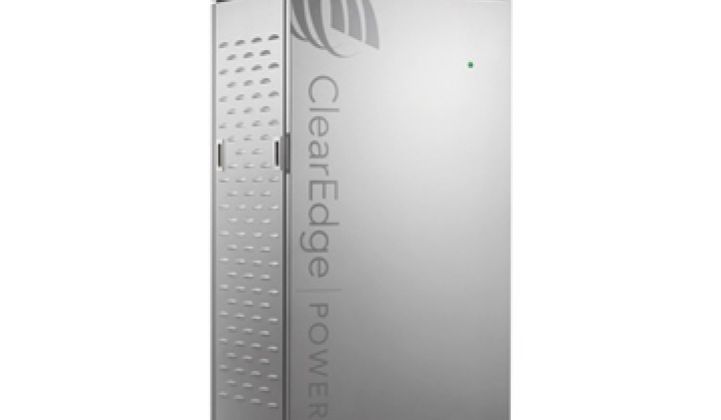ClearEdge Power is one of many aspirants looking to make technological progress and commercial inroads in the difficult fuel cell market.
ClearEdge, headquartered in Oregon with more than 200 employees worldwide, builds proton exchange membrane (PEM) fuel cells that produce electricity and heat from natural gas. Investors include Applied Ventures, Big Basin Ventures and Kohlberg Ventures.
The firm builds 5-kilowatt modules that target premium residential, small commercial and institutional stationary applications such as schools. Their PEM fuel cell incorporates a reformer and runs off of natural gas like the Bloom Energy fuel cell, although the Bloom Box is a solid oxide design, produces electricity and not heat, and comes in much larger 100-kilowatt chunks.
I spoke with Mike Upp, the VP of Marketing at ClearEdge, and he said the deals currently being closed by the firm are in the 20-kilowatt to 40-kilowatt range and involve the use of numerous 5-kilowatt boxes in a single configuration. Upp also claimed that in the "under 100-kilowatt sweet-spot" that ClearEdge services, "There is nobody else playing yet."
Upp said that ClearEdge has 100 installations operating, almost all in California, about half in residential applications. But now ClearEdge is targeting light commercial by dint of its potential for more unit sales and repeat customers.
Like the hypetastic Bloom fuel cell, the ClearEdge product is spendy. A 5-kilowatt unit has a $56,000 list price and installation can run from $12,000 to $20,000. There is a $15,000 investment tax credit and California provides a $12,500 Self Generation Incentive Program (SGIP) rebate, although the SGIP program is currently under review.
Even after incentives, the fuel cell is expensive compared to the grid or to a diesel gen-set. Certainly, the thermal component has value for hot water production or enterprise heating.
According to the firm, the 5-kilowatt unit produces generates a combined 94,800 kilowatt-hours of energy per year: 43,800 kilowatt-hours of electricity and 51,000 kilowatt-hours (equivalent to 175 million BTUs per year of heat) of useable thermal energy. ClearEdge's Oregon factory can produce 2,500 units per year and can be upgraded to reach more than 10,000 units per year.
Like all fuel cell firms, ClearEdge must continue to drive down costs while improving its long-term reliability.
ClearEdge recently received $2.8 million from the DOE’s Office of Energy Efficiency and Renewable Energy – Fuel Cell Technologies Program to deploy fuel cells in a variety of commercial buildings. ClearEdge will install its CHP system at 10 vertical markets in California and Oregon, while Pacific Northwest National Laboratory will monitor the systems and measure the expected energy savings. Deployments are meant to be varied and include schools, a car dealership, a large scale commercial laundry and uniform supply company and multi-family housing units.
The program is about market transformation -- the money is intended to defray the upfront cost of the units.
***
Here's a list of fuel cell and flow battery companies that received VC funding so far this year:
Bloom Energy raised $100M from Kleiner Perkins, NEA, and Morgan Stanley for their solid oxide fuel cell.
FutureE Fuel Cell Solutions (Germany) secured investment from Deutsche Telekom’s venture capital arm T-Venture, German development bank KfW, and the U.K.-based Entrepreneurs Fund for its PEM fuel cells ranging in power from 0.5 kilowatt to 50 kilowatts.
ReliOn (Spokane, Washington), a maker of fuel cells for backup power applications, raised $6 million from existing investors.
Intelligent Energy (Loughborough, U.K.) raised $11.4 million from existing investors such as Scottish and Southern Energy and Scottish Enterprise to develop hydrogen fuel cells.
Primus Power (Hayward, California) received $11 million funding from DBL Investors, I2BF Global Ventures, Chrysalix Energy Venture Capital, and Kleiner Perkins Caulfild and Byers to commercialize flow batteries for grid-scale energy storage.
ACAL Energy (Cheshire, U.K.), a developer of PEM fuel cell systems based on platinum-free technology, won $4.1 million from I2BF, North West Fund for Energy and Environmental, Parkwalk Advisors, Carbon Trust Investments Limited (CTIL), Solvay, Porton Capital, Sumitomo and a large Japanese auto firm.
Watt Fuel Cell, a designer of SOFC fuel cells won a $122,000 investment.
Lilliputian Systems (Wilmington, Mass.) looking to commercialize a butane cartridge-powered fuel cell charger for consumer devices, raised $11.1 million of a planned $21 million financing campaign, according to SEC filings. The firm was spun out of MIT in 2002 and has raised more than $90 million from VCs including Kleiner Perkins, Atlas Venture, Fairhaven Capital, Rockport Capital, Stata Venture Partners and Altira Group.
ClearEdge Power (Hillsboro, Oregon) raised $3M for its natural gas-powered combined heat and power (CHP) fuel cells. Previous investors in ClearEdge include Applied Ventures, Big Basin Ventures and Kohlberg Ventures.
Encite (Burlington, Mass.), a stealthy fuel cell startup, raised $650,000. A patent application shows a method of forming a fuel cell on a substrate, and then forming electronics on the substrate.
***
The Defense Department is going to install 18 small-scale backup power systems operating on hydrogen fuel cells at eight military facilities as part of a joint project with the Energy Department in a $6.6 million program to assess how fuel cells operate in real-world conditions.
The fuel cells will be installed at Fort Bragg, N.C., Fort Hood, Texas., the U.S. Military Academy, West Point, N.Y., and several other locations. NREL will collect performance data for the first two of the five years the cells will be in operation.



